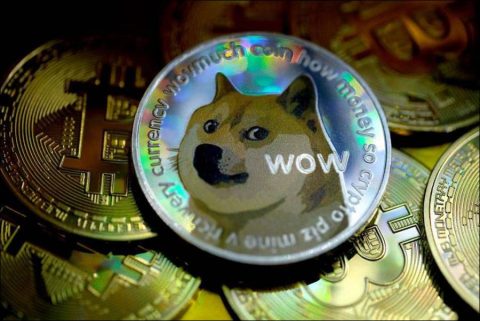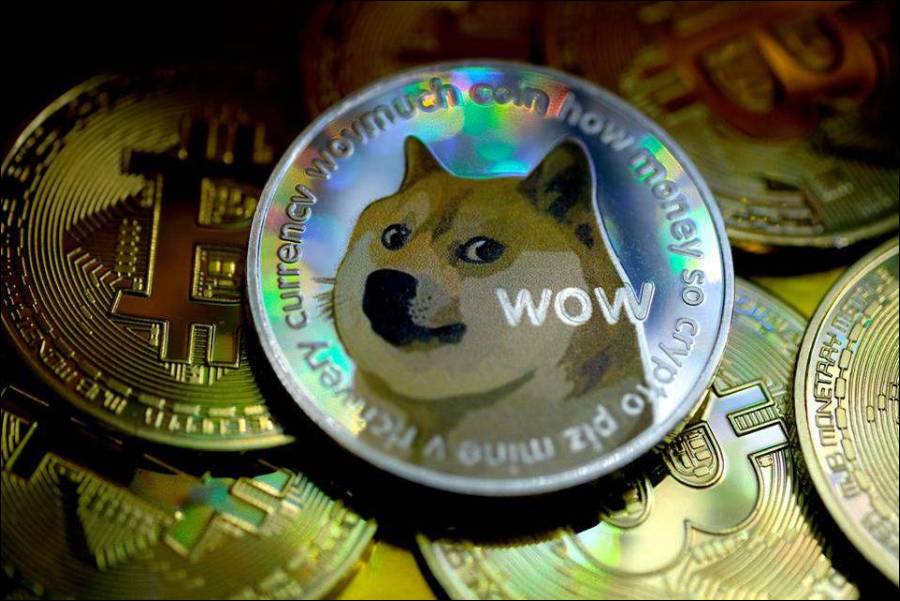Elon Musk has been conspicuously quiet about Dogecoin in recent weeks, tweeting his support for a change to its fee structure but otherwise avoiding any mention of the cryptocurrency on his feed.
Small wonder: the Shiba Inu-themed coin–launched in 2013 as a joke, but rocketed to fame this year by the Tesla CEO–has crashed harder and faster than most of its peers, losing 74% of its value since hitting an all-time-high on May 8.
Bitcoin and Ethereum are down 50% and 56% respectively over the same period amid a broad sell-off that has wiped more than $1 trillion off the combined market cap of all cryptocurrencies.
Support for the joke coin remains strong on social media channels, with members of the self-professed “Doge Army” noting that it is still the eighth largest cryptocurrency by market cap. Altcoins are generally expected to be more volatile than bitcoin, experiencing steeper price swings to both the upside and the downside.
But Musk’s reluctance to rally the troops–many of whom were introduced to Dogecoin by him–shows that the eight-year-old joke is, well, getting old. Critics of the cryptocurrency have long argued that it lacks utility and has no prospect of mainstream adoption–and not just because it’s a meme.
Dogecoin’s massive bullrun from $0.005 at the beginning of the year to $0.739 last month was driven almost entirely by celebrities like Musk and Snoop Dogg tweeting their support for the token. The endorsements struck a chord with a new generation of retail investors who were emboldened by the WallStreetBets movement on Reddit, and who had better access to crypto markets than ever before thanks to apps like Robinhood.
Few of these investors spared a thought for Dogecoin’s tokenomics–a portmanteau of token and economics that depicts the technical innovation and monetary policy underpinning a cryptocurrency.
In the cold hard light of a sell-off, that indifference looks costly. Here’s why:
Inflationary supply: Unlike bitcoin, which has a permanently fixed supply of 21m coins, Dogecoin is an inflationary token with an ever-increasing supply. Its inflation rate is programmed to fall over time, but currently involves 15m coins being minted every day (joining 130bn already in circulation). What many Dogecoin supporters don’t realize is that this model was part and parcel of the joke back in 2013. Dogecoin was amusing not just because of its branding, but because its money supply was fundamentally and purposefully designed to erode value over time. Hence the community’s self-deprecating slogans, such as “much coin, very money”.
Weak network security: cryptocurrencies such as Dogecoin and bitcoin do not have a central authority to authenticate transactions, but instead rely on multiple copies of a shared ledger that keep parallel records of all the activity on the network. This ledger is updated by miners who solve complex mathematical problems in an effort to be the first to confirm new transactions (doing so wins them a reward).
The more complex the problems, the higher the computational power–or hashrate–supporting the book-keeping, and the harder it becomes to disrupt the network with a so-called 51% attack. Dogecoin lags far behind bitcoin’s hashrate. So much so, in fact, that its relative performance is invisible to the naked eye on a comparison chart. Network security is also enhanced by the number of full nodes–or complete copies of the ledger–that are connected to the internet to help verify transactions. At the time of writing, bitcoin has about six times as many nodes as Dogecoin: 8,347 versus 1,400.
Minimal development: Musk was widely mocked last month when he claimed via a tweet that he was “Working with Doge devs to improve system transaction efficiency”. Skeptics quickly pointed out that the coin’s Github page–a repository for project developers–has been all but dead since 2017.
This, again, is no surprise: Dogecoin’s original programming code was copied with minor tweaks from Litecoin–itself a copy of bitcoin–in about three hours, according to co-creator Billy Markus. From March 2014, updates to its code have been lifted directly from bitcoin’s Github, according to developer Maximilian Keller. Development may have picked up this year, but the simple reality is that Dogecoin is a crudely modified, under-engineered ripoff of bitcoin.
In April, Musk promised to put a “literal dogecoin on the literal moon” with the help of his private rocket company, SpaceX–a reference to the iconic price meme popularized by bitcoin’s early supporters. He will need to do much more than that if Dogecoin is to live up to his followers’ expectations.Elon Musk has been conspicuously quiet about Dogecoin in recent weeks, tweeting his support for a change to its fee structure but otherwise avoiding any mention of the cryptocurrency on his feed.
Small wonder: the Shiba Inu-themed coin–launched in 2013 as a joke, but rocketed to fame this year by the Tesla CEO–has crashed harder and faster than most of its peers, losing 74% of its value since hitting an all-time-high on May 8.
Bitcoin and Ethereum are down 50% and 56% respectively over the same period amid a broad sell-off that has wiped more than $1 trillion off the combined market cap of all cryptocurrencies.
Support for the joke coin remains strong on social media channels, with members of the self-professed “Doge Army” noting that it is still the eighth largest cryptocurrency by market cap. Altcoins are generally expected to be more volatile than bitcoin, experiencing steeper price swings to both the upside and the downside.
But Musk’s reluctance to rally the troops–many of whom were introduced to Dogecoin by him–shows that the eight-year-old joke is, well, getting old. Critics of the cryptocurrency have long argued that it lacks utility and has no prospect of mainstream adoption–and not just because it’s a meme.
Dogecoin’s massive bullrun from $0.005 at the beginning of the year to $0.739 last month was driven almost entirely by celebrities like Musk and Snoop Dogg tweeting their support for the token. The endorsements struck a chord with a new generation of retail investors who were emboldened by the WallStreetBets movement on Reddit, and who had better access to crypto markets than ever before thanks to apps like Robinhood.
Few of these investors spared a thought for Dogecoin’s tokenomics–a portmanteau of token and economics that depicts the technical innovation and monetary policy underpinning a cryptocurrency.
In the cold hard light of a sell-off, that indifference looks costly. Here’s why:
Inflationary supply: unlike bitcoin, which has a permanently fixed supply of 21m coins, Dogecoin is an inflationary token with an ever-increasing supply. Its inflation rate is programmed to fall over time, but currently involves 15m coins being minted every day (joining 130bn already in circulation).
What many Dogecoin supporters don’t realize is that this model was part and parcel of the joke back in 2013. Dogecoin was amusing not just because of its branding, but because its money supply was fundamentally and purposefully designed to erode value over time. Hence the community’s self-deprecating slogans, such as “much coin, very money”.
Weak network security: cryptocurrencies such as Dogecoin and bitcoin do not have a central authority to authenticate transactions, but instead rely on multiple copies of a shared ledger that keep parallel records of all the activity on the network. This ledger is updated by miners who solve complex mathematical problems in an effort to be the first to confirm new transactions (doing so wins them a reward).
The more complex the problems, the higher the computational power–or hashrate–supporting the book-keeping, and the harder it becomes to disrupt the network with a so-called 51% attack. Dogecoin lags far behind bitcoin’s hashrate. So much so, in fact, that its relative performance is invisible to the naked eye on a comparison chart. Network security is also enhanced by the number of full nodes–or complete copies of the ledger–that are connected to the internet to help verify transactions. At the time of writing, bitcoin has about six times as many nodes as Dogecoin: 8,347 versus 1,400.
Minimal development: Musk was widely mocked last month when he claimed via a tweet that he was “Working with Doge devs to improve system transaction efficiency”. Skeptics quickly pointed out that the coin’s Github page–a repository for project developers–has been all but dead since 2017.
This, again, is no surprise: Dogecoin’s original programming code was copied with minor tweaks from Litecoin–itself a copy of bitcoin–in about three hours, according to co-creator Billy Markus. From March 2014, updates to its code have been lifted directly from bitcoin’s Github, according to developer Maximilian Keller. Development may have picked up this year, but the simple reality is that Dogecoin is a crudely modified, under-engineered ripoff of bitcoin.
In April, Musk promised to put a “literal dogecoin on the literal moon” with the help of his private rocket company, SpaceX–a reference to the iconic price meme popularized by bitcoin’s early supporters. He will need to do much more than that if Dogecoin is to live up to his followers’ expectations.
Visits: 56




